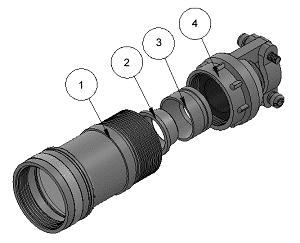Circular Connector Backshell FAQ
Selecting the correct backshell for your application is critical to achieving the required level of performance from your end to end interconnect solution. In this article NYKCS answers some of the common questions associated with circular connector backshells. If you need further guidance or information please do not hesitate to contact us.
What factors impact backshell selection?
Backshell selection begins with identifying the application and defining how the completed interconnect solution will be used.
Factors to define include:
- Exposure to dirt, moisture, electrical or radio interference;
- Connector type (range, style, size, shape)
- Cable diameter size;
- Shielded or Non-shielded cable;
- Shape or cable routing restrictions;
- Performance specification and requirements i.e Mil Spec, EMI, RFI, etc.
What are the main backshell types and how do I select the right one?
Based on the design and application demands, select the backshell type you’ll need from one of the following families:
Non-Environmental: Will be used where no harsh environment will be present (dust, dirt, moisture, fluids, salt.) Suitable for an inside the box/climate controlled room application or where there is a requirement for additional space between the rear of the connector and the strain relief to allow for cable service loops, etc.
Environmental: Will be used in a harsh environment (dust, dirt, moisture, fluids, salt, temperature extremes.) Most common military specification cylindrical connectors are designed so that they will be environmentally sealed once the backshell or strain relief is secured.
Non-Environmental EMI/RFI: Will be used in an area susceptible to the reception of Electromagnetic Interference (EMI) and Radio Frequency Interference (RFI) where no harsh environment will be present (dust, dirt, moisture, fluids, salt.) EMIs and RFIs originate from coils, electromagnets, electric motors, transformers, fluorescent lighting, high power radar, broadcast stations and other communications circuits.
Environmental EMI/RFI: Will be used in a harsh environment (dust, dirt, moisture, fluids, salt) area susceptible to the reception of Electromagnetic Interference (EMI) and Radio Frequency Interference (RFI.) EMIs and RFIs originate from coils, electromagnets, electric motors, transformers, fluorescent lighting, high power radar, broadcast stations and other communications circuits.
How do I select the right backshell shape and coupling style?
Determine the most appropriate shape and coupling style that meets your cable routing, space and performance requirements. The backshell styles available are:
- Straight;
- 90 Degree;
- 45 Degree;
- Spin Coupling;
- Direct Coupling;
- Anti-vibration.
How do I cross reference between suppliers?
NYKCS provides complementary connector backshells from leading trusted OEM’s and has an exclusive European franchise with Compaero. We offer a comprehensive range of Compaero products as alternatives to the TE/Polamco and Glenair products. Our Polamco to Compaero Cross Reference tool is a useful resource for finding the right backshell solution for your application.
How do I assemble an EMI/RFI backshell?
Assembly Notes
1. Be sure to use the proper tools to ensure correct, reliable results
2. Assembly instructions are meant as an overall guide. Variations in cable type, connector series, braid style and other factors may require the steps below to be altered. It is suggested to use a trial sample to determine proper trim dimensions and identify assembly variations.
Backshell Assembly Steps:
Step 1: Assemble barrel (1) to connector.
Step 2: slide cable through barrel (1) and against rear accessory end of connector.
Step 3: Mark cable at rear end of barrel. if cable requires service loops or other factors requiring added length please compensate when marking cable in this step.
Step 4: Remove barrel (1) from connector and place entire backshell assembly (1-4) onto cable as pictured above. Verify that cable clamp (4) includes bushing and sleeve.
Step 5: Strip outer cable jacket and outer shield (braid) at marked point made in step 3.
Step 6: approximately 0.75” from strip point (step 5) remove just the outer cable jacket while leaving outer shield.
Step 7: Terminate and wire individual conductors onto connector.
Step 8: Assemble barrel (1) onto accessory threads of connector.
Step 9: Slide inner ferrule (2) into barrel (1).
Step 10: Carefully flare outer shield (braid) over inner ferrule (2).
Step 11: Encapsulate outer shield (braid) by sliding outer ferrule (3) into barrel (1) over inner ferrule (2).
Step 12: Tighten cable clamp (4) onto barrel (1) making sure that the bushing seals against the outer jacket of the cable.
For more information read our second FAQ article.
